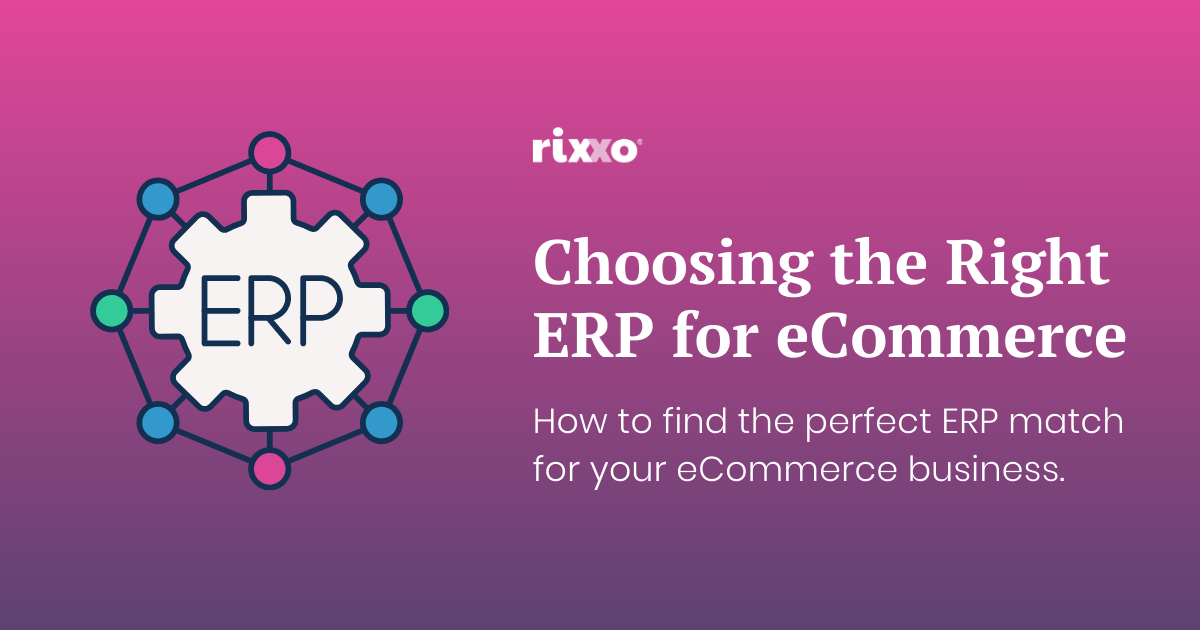Finding Your Perfect Match: How to Choose the Right eCommerce ERP Solution for Your Business

So you’ve begun exploring ERP systems for your eCommerce business. You’re aware of the benefits that ERP can bring, including smoother operations and improved customer service. You’ve concluded that the telltale signs that your business is ready for an ERP integration are there to see.
So where to begin?
There are so many platforms to choose from, finding the right eCommerce ERP solution that’s right for your business is complicated and fraught with potential pitfalls. Without careful planning, businesses risk headaches, wasting time, and incurring unnecessary expenses.
As an eCommerce agency specialising in B2B, we have guided many clients through the complexities of ERP integration, from initial assessment to implementation and support.
We’re here to share our insights to help you avoid common mistakes when choosing an ERP. Our goal is to ensure your journey towards integrating an ERP solution is smooth and that you make the right choice, first time.
Let’s look at how you can find the perfect ERP match for your eCommerce business, beginning with a thorough assessment of your business’s current state of play.
Assessing business needs for ERP integration


Identifying what your business needs from an ERP system begins with a comprehensive review of your current operations. Focus on areas such as inventory management and the order fulfilment process. Ask yourself if these processes could be more efficient or if there are opportunities for improvement.
Understanding your current operations and challenges
Consider a manufacturing business that sells products online. The company struggles with tracking which items are available, leading to delays in order processing and, occasionally, selling products that are out of stock. After reviewing its operations, the business identifies the need for an ERP system that offers real-time inventory tracking and automated order processing.
By implementing an ERP solution with these specific features, the company can immediately see which items are available and process orders more efficiently, reducing wait times for customers and avoiding the sale of unavailable items. This practical change directly addresses the operational challenges faced by the business, illustrating how a focused assessment of needs leads to the selection of technology that enhances business operations.
Assessing compatibility and infrastructure
Next, evaluate your current software, hardware, and data infrastructure to ensure compatibility with the new ERP system. Here’s a list of the things you’ll need to check:
- List all current software applications, hardware components, and data storage used by your organisation.
- Analyse data quality and accessibility, assessing the integration potential with the new ERP system.
- Check hardware infrastructure to ensure it can support the ERP system requirements.
- Review security measures and compliance standards to identify any areas needing improvement before integration.
Data quality encompasses several aspects:
- Accuracy: The data should be correct and up-to-date, reflecting a true picture of the business operations.
- Completeness: Data sets should be comprehensive, with all necessary information present and accounted for.
- Consistency: The same data should appear across different systems or databases.
- Reliability: The data should be dependable and stable over time, providing a solid basis for making business decisions.
Accessibility relates to how easily this data can be retrieved and used:
- Ease of retrieval: The data should be easy to find and extract from your systems when needed.
- Format and structure: Data should be in a format that’s readily usable and compatible with new systems. This includes considering whether data is structured (easily quantifiable and stored in databases) or unstructured (text-heavy and not as easily searchable, like emails or documents).
- Permissions and security: The right users should have access to the data they need, while sensitive information remains protected.
Assessing data quality and accessibility ensures that the ERP will effectively leverage your existing data, enhancing business operations without requiring extensive data cleanup or restructuring. This foundational step helps to ensure the new system can provide accurate insights and support efficient processes from day one.
Reviewing security measures and compliance: This means assessing your current security protocols and compliance with relevant regulations to find where you might need to make improvements before integrating a new ERP system. It involves:
- Security measures: Look at the protections you have against unauthorised access, breaches, and other cybersecurity threats. This includes firewalls, encryption, access controls, and data backup methods.
- Compliance standards: Checking how well your current practices meet industry regulations and standards relevant to your business. This could involve GDPR for data protection, HIPAA for healthcare information, or PCI DSS for payment data security.
The aim is to ensure that before introducing a new ERP system to your IT environment, your security and compliance frameworks are strong enough to prevent vulnerabilities and issues with non-compliance. Identifying areas for improvement allows you to address these gaps, ensuring the new system can securely integrate into your setup and help maintain or improve your compliance stance.
Setting goals


Clear goal-setting is fundamental for the successful implementation of an ERP system. Establishing well-defined objectives early on guides the selection process, ensuring that the ERP solution you choose closely aligns with your business needs. It also sets a benchmark for measuring the success of the ERP integration, allowing you to monitor progress and make adjustments as necessary.
For example, one goal might be to enhance operational efficiency. This could involve automating manual processes to save time and reduce errors, ensuring that your team can focus on more strategic tasks. Another common objective is improving customer satisfaction. By using an ERP system to provide real-time inventory updates and faster order processing, you can deliver a better shopping experience, leading to increased customer loyalty.
Streamlining operations is also a significant goal for many businesses. An ERP system can integrate various functions—such as finance, HR, and sales—into a single platform, eliminating data silos and improving communication between departments. This integrated approach makes it easier to manage your business and also provides more accurate and comprehensive data for decision-making.
By setting clear goals for your ERP implementation, you can ensure that the system you choose meets your current needs and has the flexibility to adapt as your business grows and evolves. This strategic planning helps to maximise the return on your ERP investment.
Remember – Your business goals should steer your choice of technology. The ERP you choose should enhance and support your operational strategies. Technology should serve as a tool to achieve your objectives, not dictate how you run your operations.
Budget planning


Preparing a budget for your ERP integration involves carefully considering initial costs, ongoing expenses, and training needs. A well-thought-out budget ensures you cover all aspects of the ERP integration, helping you avoid unexpected costs that could throw off your financial planning.
Initial costs
These include buying the ERP software or paying subscription fees for a cloud-based solution. Don’t forget to account for customisations that may be needed to make the system fit your specific business needs. Also, consider the expenses for hardware upgrades or additional equipment the ERP system requires.
Outsourcing can save time and money
Investing in expert advice from the outset can save money and time in the longer term. Consultants with expertise in delivering ERP eCommerce integrations can help you avoid common pitfalls, ensure your system is perfectly tailored to your needs, and even negotiate better terms with vendors.
Ongoing expenses
After the initial setup, maintaining your ERP system comes with its own costs. These can be annual license fees, subscription renewals, and support services. Regular updates and system upgrades might also lead to further expenses, keeping your ERP system effective and secure over time.
Again this is where bringing in an external team can pay dividends. An experienced agency can advise and quote for ongoing support packages, which means you’ll know exactly what to budget for and you’ll never be stuck without technical support.
Training
Training your team to use the ERP system is essential. Your budget should cover the initial training sessions at implementation and ongoing training to keep staff updated with system changes and new features. This might mean in-house training sessions, online courses, or workshops from the ERP provider.
Stressing the importance of a realistic budget is crucial. Your budget must cover all related costs, including those not immediately obvious. For example, you might face a temporary drop in productivity during the switch or need to pay extra for consultancy services to optimise the system.
A carefully planned budget, focused on realism and a comprehensive view of costs, lays a strong foundation for your ERP project. It prepares you financially and contributes to a smoother implementation process, reducing the risk of putting your business under financial stress.
Researching and shortlisting vendors
Finding the right ERP provider requires careful research, especially one with expertise in your industry. Providers who understand your sector can offer tailored solutions and insights into best practices, giving you a competitive edge. Here’s how to approach researching and shortlisting vendors:
Identify industry specialists: Start by identifying ERP providers known for their expertise in your industry. Look for case studies, client testimonials, and industry awards that highlight their capabilities and success stories with businesses similar to yours.
Match features with needs: Make a list of essential features you need from an ERP system, based on the goals and needs you’ve identified. When researching vendors, focus on those whose platforms offer these key functionalities. This ensures the system you choose can support your specific operational requirements.
Consider vendor reputation: Research each vendor’s reputation in the market. Read online reviews, ask for references, and reach out to your network for firsthand accounts of their experiences. A vendor with a strong, positive reputation is more likely to provide reliable service and support.
Evaluate integration capabilities: Ensure the ERP systems you’re considering can integrate smoothly with your existing tools and software. This is crucial for maintaining data consistency and streamlining workflows across your business operations.
Check scalability: Your chosen ERP system should be able to grow with your business. Look for solutions that offer scalability, allowing you to add features or users as your business expands without needing a complete system overhaul.
Draft a shortlist: After research and evaluation, draft a shortlist of vendors that best match your specific needs and industry requirements. This list should be a mix of providers that offer the functionalities you need, have a strong industry reputation, and can deliver scalable solutions.
Consult with an expert: Bringing in an expert team for consultation can significantly streamline your search for the perfect ERP system. At Rixxo we take a deep dive into your business, assess your specific needs, and offer the best advice on ERP solutions for your unique situation.
This step can be a valuable shortcut, helping you focus your search on the most suitable options without spending unnecessary time and resources.
By following these steps you’ll be well-positioned to select an ERP vendor that not only understands the unique challenges and opportunities of your industry but also offers a solution that is closely aligned with your business goals and operational needs.
Conclusion
Finding the right eCommerce ERP solution is important. It affects how well your business runs and how much it can scale. We’ve shown you steps to help you think about what you need, set goals, figure out how much you can spend, and pick the right system.
Remember, the right ERP solution doesn’t just solve current problems—it also positions your business to adapt and thrive.
And remember, if you’re feeling stuck or overwhelmed, we’re here waiting and ready to talk all things ERP & eCommerce integration with you.
